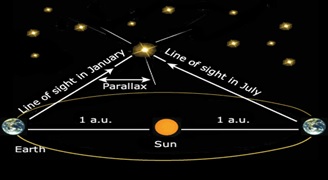21 September, 2025
Stellar parallax
Tue 09 Sep, 2025
Context
The concept of stellar parallax has been foundational in shaping modern astronomy and understanding the vastness of space. First conceptualized to explain how stars appear to move relative to each other from different positions on Earth, stellar parallax serves as a crucial method for measuring astronomical distances. It is one of the earliest and most direct methods to determine the distance to nearby stars and laid the groundwork for modern astrophysics and cosmology.
What is Stellar Parallax?
- Stellar parallax is defined as the apparent shift in the position of a nearby star against the backdrop of more distant stars when observed from two different positions in Earth's orbit around the Sun, typically six months apart.
- This phenomenon is a direct result of Earth's motion through space. As the Earth moves from one side of its orbit to the opposite side, the angle from which a star is observed changes slightly. This angular displacement is called the parallax angle.
- This angle is tiny—often measured in arcseconds (1/3600 of a degree)—but it becomes significant in measuring stellar distances. The closer a star is to Earth, the greater the observed parallax.
Historical Background
- Although Aristarchus of Samos suggested the concept of heliocentrism in the 3rd century BCE, the lack of observable stellar parallax at the time was one of the arguments against it.
- The first successful measurement of stellar parallax was achieved by Friedrich Bessel in 1838, for the star 61 Cygni. His work marked the first scientific proof that stars were at measurable distances from Earth.
How is it Measured?
- To measure stellar parallax, astronomers observe a star at two different times of the year—typically six months apart—when the Earth is on opposite sides of its orbit.
- The parallax angle (p) is half the total angular shift observed. Using this angle, the distance (d) to a star can be calculated using the formula:
|
d=1pd = \frac{1}{p}d=p1 Where: ddd is the distance in parsecs (pc). ppp is the parallax angle in arcseconds. 1 parsec ≈ 3.26 light years |
For example, if a star shows a parallax angle of 0.1 arcseconds, it is located at a distance of 10 parsecs.
Importance in Astronomy
- Primary Distance Measurement: Parallax is the only direct method for determining distances to stars, which is essential for scaling the cosmos.
- Calibration Tool: It is used to calibrate other indirect distance-measuring methods such as the Cepheid variable method and Tully-Fisher relation.
- Foundation of the Cosmic Distance Ladder: All higher rungs of distance measurements in astronomy are dependent on parallax at the base.
Modern Advances
With the launch of precision instruments like the Gaia space observatory by the European Space Agency, stellar parallax can now be measured for stars thousands of light-years away with incredible accuracy.
- Hipparcos (1989–1993): First space mission to map parallax for over 100,000 stars.
- Gaia Mission (2013–present): Aims to chart over 1 billion stars, improving parallax accuracy down to microarcseconds.
These missions have revolutionized our knowledge of the Milky Way, enabling 3D maps of stellar positions and motions.
Challenges
- Parallax angles are extremely small; ground-based observations are limited by atmospheric distortion.
- Measurement errors grow with increasing distance, limiting its use to relatively nearby stars (within a few thousand light-years).
Conclusion
Stellar parallax is more than a geometric curiosity—it is a cornerstone of celestial measurement. It not only affirms Earth’s motion around the Sun but also opens up a reliable window into the scale and structure of our universe. As space-based observations continue to refine our understanding, parallax remains a testament to the power of observation and geometry in decoding the cosmos.


















